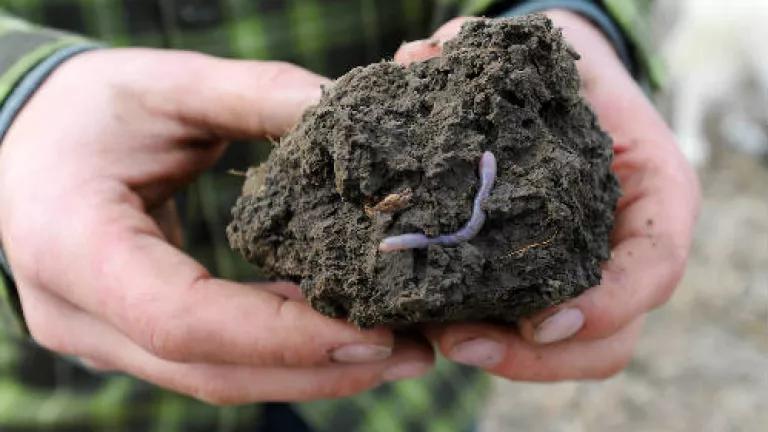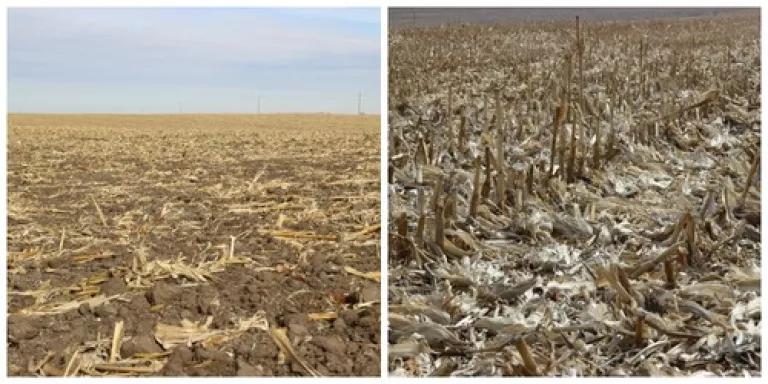
Did you know that 2015 is the International Year of Soils?
Each month, the USDA is celebrating the International Year of Soils by focusing on a different benefit of healthy soil. I kicked off January's theme of "Soils Sustain Life" at the Southern Soil Health Conference in Fort Worth, Texas.
At the conference, which NRDC helped to sponsor, I heard story after story about soils sustaining life on farms across the country. The inspiring line-up of farmers on the agenda discussed the importance of the following five principles of soil health to sustaining life on their operations:
Minimize mechanical disturbance
The first principle of healthy soil is to minimize the amount of disturbance you're causing to the billions of busy inhabitants of the soil. One of my favorite facts is that there can be more life in a handful of healthy soil than there are people on Earth! Microbes, earthworms, and fungi all make their homes beneath the ground and work together to make the soil a healthy place for plants to grow. Practices like tillage that disturb the soil destroy these little critters' home and limit what they can do to promote crop growth.
Photo: USDA Natural Resources Conservation Service - Iowa
Take, for example, the tunnels that earthworms burrow throughout the ground. Those little tunnels make great "raincatchers" to capture moisture in crops' root zones and help make sure that every drop of rain can benefit crop growth. But tillage ruins those handy little tunnels, meaning the soil can't hold as much water, which could be the difference between profit and loss during dry years. As Gabe Brown, rancher and former NRDC Growing Green Award Winner, put it at the conference, "It's not how much rainfall you get. It's how much you can infiltrate."
Put "armor" on the soil surface
The second principle of healthy soil is to protect the soil with "armor." Armor can be pretty much anything that covers up the soil, such as residue from previous crops that's left in place through no-till planting methods, or cover crops that protect the soil when it would otherwise be bare. "Bare soil is a disaster waiting to happen," said Gabe. And he's right. With humans eroding soil more than 100 times the rate of nature, we need to do all we can to protect this precious resource from wind and water erosion.

The above photos were taken on the same day on two corn fields that are across the road from one another in Cass County, Nebraska. The fall tilled field on the left is eroding due to Nebraska's infamous winter winds--notice the bare soil exposed to the elements. The no-till field on the right is "armored' against the elements and is not eroding. Photos: Tamara Althouse
"Armor" also protects the soil and growing plants from intense summer heat and preserves moisture. Just like mulch keeps your garden moist and cool and your plants happy, residue or cover crops can help keep your field habitable for your crops, which is increasingly important as climate change is bringing more frequent extreme weather to the farm.
Maximize diversity
The third principle of healthy soil is to maximize diversity on the farm. Different microbes require different plants to thrive, so adding diversity makes sure you're feeding a variety of soil biota and increasing biological activity. Furthermore, including a variety of plant heights, root depths, and leaf shapes ensures you're harvesting as much sunlight as possible and converting it into "food" for the soil.
Adding diversity can be challenging for farmers who are used to growing only certain crops. However, a growing number of farmers are starting to add diversity through the use of cover crops, which can be worked into farmers' existing crop rotations. The key, according to Terry McAllister, who farms in Electra, Texas, is to be open-minded about trying new things. "What can we grow?" McAllister asked. "I don't think we ever really knew, because we weren't open-minded."
Keep living roots in the ground as long as possible
The fourth principle of healthy soil is to keep things growing in it as long as possible, again to keep feeding the biota in the soil. For farmers in dry areas, this may seem counterintuitive--they may be afraid of "using up" all their available water. But it's doable, and healthier soil will help you hold more water when it does rain. Each 1% increase in soil organic matter will help you hold 27,000 more gallonsof water per acre.
"Mindset is the biggest challenge as you make the shift," said Scott Ravenkamp, who farms without irrigation in Hugo, Colorado, where it's notoriously dry. "You gotta take the 't' out of 'can't'," he said. As Scott transitioned away from a summer fallow toward a continuous cropping rotation, he saw the benefits of improved soil health actually improve his productivity in a dry climate-- he was able to capture and use the moisture that did fall. The key, according to Scott, is to apply this principle in a way that works for you and base your cropping decisions on what's needed to improve soil health.
Include appropriate animals on the land
Finally, the fifth principle of soil health is to incorporate animals into your rotation. This is perhaps the biggest shift of all for some farmers, but science shows that responsible grazing can help improve diversity, provide needed nutrients and improve overall soil health. It makes sense when you think about it; the native systems that regenerative agriculture attempts to mimic all included animals, such as the massive herds of bison that used to roam across my native state of Nebraska. Bringing animals responsibly back into your rotation is the next step toward farming in nature's image. "We are trying to learn how to be a part of nature instead of fighting it," says Texas farmer Jonathan Cobb, of his efforts to shift toward livestock farming. "It's so much more enjoyable that way."
My key takeaway from these inspiring stories is that the Principles of Soil Health can be applied to sustain life on every type of farming situation. Although each of these farms varied in location, size, and crops grown, they all adapted the Principles of Soil Health to suit their operations' needs. The situation and individual strategies varied, but the Principles remained the same.
Stay tuned for more on the importance of healthy soil throughout the year, including next month's focus on how "Soils support Urban Life."

